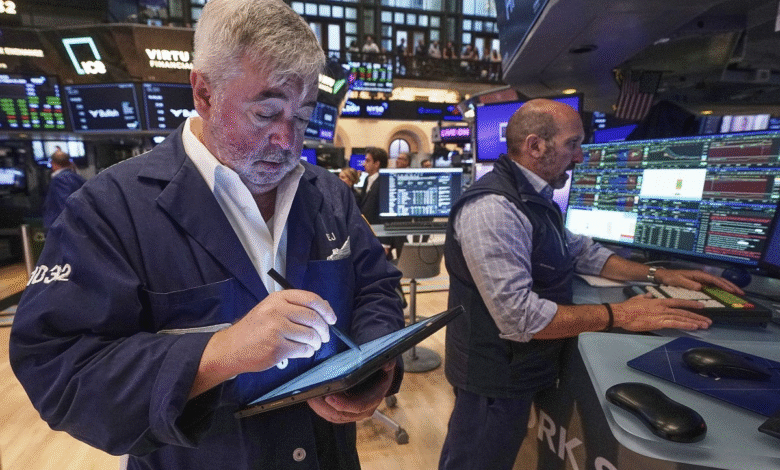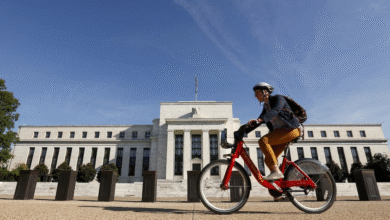Interest Rates: Goolsbee Comments on Future Trajectory

Interest rates play a pivotal role in shaping the economic landscape, and recent comments from Chicago Federal Reserve President Austan Goolsbee underscore their significance amidst a backdrop of mixed inflation data. As the Federal Open Market Committee (FOMC) meeting approaches on September 16-17, there is increasing scrutiny on the potential for adjustments in rates. Goolsbee emphasized the necessity for “some clarity from the numbers” before any commitment to lowering interest rates can be made, especially in light of ongoing inflation trends and tariff concerns. His remarks highlight the importance of understanding how these factors intertwine to impact the overall economic outlook. With market forecasts indicating a strong chance of a rate reduction, the upcoming discussions are set to stir significant interest among economists and investors alike.
The concept of borrowing costs is critical to both consumer behavior and business investments, and it is closely tied to the actions of the Federal Reserve. In light of recent economic developments, the dialogue surrounding the potential adjustments to these expenses has grown increasingly complex. Goolsbee’s cautious perspective reflects the delicate balance that the Fed must strike as they approach their next decision-making meeting. As inflation continues to reveal mixed signals, understanding the implications of financial rates becomes essential for navigating these economic currents. Observing how the interplay of various economic indicators, such as labor market stability and tariff effects, influences the pathway of these costs will be crucial in predicting future fiscal strategies.
The Impact of Inflation Trends on Interest Rates
Inflation trends play a pivotal role in shaping monetary policy and the decisions made by the Federal Reserve regarding interest rates. Recently, Chicago Federal Reserve President Austan Goolsbee highlighted the mixed messages conveyed by current inflation data, expressing the need for further clarity before the Federal Open Market Committee (FOMC) can confidently consider lowering interest rates. The July consumer price index (CPI) report reflected that while some indicators were as expected, the core CPI—excluding food and energy—rose to 3.1%, surpassing Wall Street forecasts. This increase is significant as it suggests persistent inflation pressures, especially in prices for essential services that tend to be less transient in nature.
The upcoming FOMC meeting on September 16-17 will be crucial in determining whether adjustments to the federal funds rate can occur. Goolsbee’s stance follows the concept of a ‘golden path,’ where inflation decreases but the labor market remains robust, allowing for potential interest rate cuts. However, as Goolsbee notes, more inflation reports are needed to draw a definitive conclusion about the economic outlook and the feasibility of reducing interest rates without jeopardizing economic stability.
As the Federal Reserve navigates these choppy waters, the anticipation surrounding interest rate changes grows among investors and economists alike. Financial markets currently indicate a strong possibility of a quarter-point reduction in the federal funds rate, which would see rates drop from 4.25% to 4.50%. This imminent decision underscores the delicate balance the Fed must maintain between stimulating growth through lower interest rates and controlling inflationary pressures that could undermine economic stability. Observations from Goolsbee concerning tariff influences on inflation trends further complicate this decision-making process; although early data has suggested limited effects, the long-term implications of ongoing tariffs may ultimately add inflationary pressures to the economy.
Expectations for the Upcoming FOMC Meeting
As we approach the crucial FOMC meeting in mid-September, market expectations are swirling regarding the potential for interest rate reduction. With inflation reports showing mixed signals, particularly the unexpected rise in the core producer price index (PPI), the Federal Reserve faces a critical juncture. Goolsbee emphasized the need for clarity in the inflation data, noting that a continued upward trend could deter any immediate plans for rate cuts. He expressed a desire to see ‘at least one more inflation report’ before committing to any policy changes, indicating that the Fed’s decisions will be data-driven and reflect the complexity of the current economic environment.
Moreover, investors are closely monitoring probabilities for future rate adjustments, with current assessments indicating a 55% chance of a second rate cut in October and only 43% likelihood of a further cut in December. This uncertainty is a double-edged sword; while an initial cut could bolster market confidence, any signs of continued inflationary pressures might prompt the Fed to reassess its approach, leading to increased caution in subsequent meetings.
The discussions leading into the FOMC meeting also reflect broader economic concerns, particularly regarding how external factors like international tariffs are affecting inflation trends domestically. While early analyses suggested minimal impacts from tariffs set by the Trump administration, Goolsbee hinted at potential delayed effects becoming obvious in future reports. This places the Fed in a delicate position, aiming to strike a balance between fostering economic growth through lower interest rates and maintaining control over inflation. As members deliberate in the upcoming meetings, the interplay of these economic forces will dictate the Federal Reserve’s course of action in the months ahead.
Economic Outlook Amidst Rising Prices
As inflation remains in focus, Goolsbee’s insights reveal a cautious optimism concerning the U.S. economic outlook. He has posited that the economy might still follow a ‘golden path’—a scenario where inflation eases while the labor market stays robust. However, the recent upward movement in core price indicators casts a shadow of doubt on this optimistic view, making it imperative for the Fed to proceed carefully. The mixed inflation data not only complicates the Federal Reserve’s decision-making but also poses a challenge for businesses and consumers navigating their own financial strategies in a potentially fluctuating economic landscape.
If inflation continues to trend upwards, this could jeopardize the Fed’s ability to implement interest rate cuts as a stimulus measure; instead, they might need to prioritize inflation control to ensure long-term economic health. Goolsbee’s statements reflect this complexity as he acknowledges that understanding the depth of the economic impacts of tariffs might still be unfolding, which adds to the uncertainty of the economic outlook and the potential trajectory of interest rates.
Additionally, the current economic climate highlights the necessity for various sectors to recalibrate in response to rising prices. Businesses may need to anticipate changes in consumer behavior, while workers might start to feel the strain of reduced purchasing power. With the labor market remaining a crucial element of this narrative, the Federal Reserve will be vigilant in monitoring employment data as a key barometer for economic health. The decisions made during the FOMC meeting will not just shape interest rate policies but will also serve as a response to broader economic sentiments that reflect the intricacies and challenges posed by ongoing inflation trends.
The Fed’s Response to Tariff Influences on Inflation
The relationship between tariffs and inflation trends has become a significant focal point for the Federal Reserve, particularly as President Trump’s trade policies have begun to bear mixed results. Goolsbee’s recent comments underscore the Fed’s need to analyze how these tariffs might influence consumer prices in the long run. While initial data suggested limited immediate impacts on inflation, the expectation is that the cumulative effects of tariffs could surface in future inflation reports, complicating the Federal Reserve’s task of setting interest rates. Understanding these dynamics is crucial, as any unexpected inflation uptick could limit the Fed’s ability to reduce rates, impacting both economic growth and consumer sentiment.
Moreover, the anticipation of forthcoming inflation data places additional pressure on the Fed to maintain a proactive approach. If tariffs start to manifest as significant inflationary pressures, the Federal Reserve may shift strategy to counteract this trend. The fluctuating landscape of tariffs and their impact on inflation trends highlight the importance of continuous economic monitoring and adjustment, as external variables play an increasingly vital role in determining the Fed’s monetary policy direction.
In this context, Goolsbee’s statements reflect a prudent recognition of the complexities that inform the Federal Reserve’s policy decisions. With the FOMC meeting approaching, the Fed’s response to evolving inflation trends driven by tariff influences will be assessed not just for its immediate effects, but for its longer-term implications on the economy. The goal remains to achieve sustainable growth while keeping inflation in check, a balance that becomes more challenging in light of the uncertainty posed by ongoing tariff debates.
Understanding the Core Inflation Metrics
Core inflation metrics play a crucial role in guiding the Federal Reserve’s policy decisions, and Goolsbee’s remarks draw attention to their significance in light of current economic conditions. The recent rise in core CPI, which excludes volatile food and energy prices, signals persistent inflationary pressures that the Fed must address before considering interest rate cuts. By focusing on core metrics, the Fed aims to gain a clearer understanding of underlying inflation trends, which helps to inform their decisions and provide a more stable economic outlook in a rapidly changing environment.
Goolsbee’s caution surrounding the recent inflation reports illustrates the need for careful monitoring—especially as continued increases in core inflation could complicate the Fed’s plans to lower interest rates. Economists often analyze these core metrics in conjunction with other economic indicators, as they provide a more reliable picture of price stability and future inflation expectations. The significance of the core CPI’s recent behavior suggests that even amid a strong labor market, the Federal Reserve must remain vigilant about inflation’s potential impacts on economic growth.
Furthermore, as discussions around the FOMC meeting unfold, the importance of understanding core inflation metrics becomes increasingly apparent. Investors and financial analysts are keenly aware that any deviations from anticipated core inflation trends could reshape market expectations surrounding interest rate movements. Therefore, Goolsbee’s emphasis on core inflation is not merely academic; it directly influences the Fed’s policy toolkit and the broader economic landscape. For stakeholders across the economy, keeping a pulse on these core measurements will be essential for navigating uncertainties that could arise from shifting Fed strategies.
The Role of Economic Sentiment in Rate Decisions
Economic sentiment often drives the decisions of the Federal Reserve, especially as it relates to perceptions of consumer spending and business investment. As Goolsbee pointed out, the uncertain inflation trends could lead to wavering confidence among consumers and investors alike, which can influence economic performance. The sensitivity of economic sentiment to changes in the Fed’s interest rate policy means that any premature or ill-fated decisions could affect consumer behavior and overall growth. Thus, keeping track of economic sentiment indicators is essential as the Fed deliberates its next moves.
Additionally, the Fed’s approach to nurturing a positive economic outlook entails effectively communicating its intentions regarding interest rate changes. With mixed inflation data and ongoing tariff concerns at play, Goolsbee’s insights remind us that sentiment can be as powerful as numbers in predicting economic momentum. If consumers and businesses feel uncertain about the inflation trajectory, their spending habits could shift, potentially stifling growth and altering the landscape of what the Fed perceives as a strong economy. The interplay between sentiment and rates therefore underscores the necessity of a carefully crafted monetary policy.
In the lead-up to the FOMC meeting, recognizing the complex web of factors influencing economic sentiment will be crucial for effective policy-making. Should sentiment decline due to persistent inflation concerns, the Fed might need to assuage fears through transparent communication and strategic planning. With the strength of the labor market in mind, the Fed must weigh the importance of fostering economic confidence against the realities of inflation trends. By considering both economic data and sentiment, the Federal Reserve can better position itself to navigate the challenges ahead.
Market Reactions to Fed Interest Rate Speculations
Market reactions to interest rate speculations play a significant role in shaping economic dynamics, particularly as the FOMC meeting approaches. Current expectations suggest a strong likelihood of a quarter-point reduction in rates. Financial markets reflect a keen sensitivity to the anticipated decisions of the Federal Reserve, with traders reacting swiftly to changes in inflation outlooks. This is evidenced by the fluctuations in stock and bond markets as investors try to predict the outcomes of interest rate adjustments, which can significantly influence investment decisions and economic growth forecasts.
Goolsbee’s insights on the current inflation data highlight how uncertainty in rate decisions can lead to increased volatility in the markets. A robust labor market, coupled with rising inflation metrics, creates a complex environment, prompting investors to reassess strategies and consider the implications of potential rate cuts. As markets show a 55% likelihood of cuts in October and a lower probability for December, these speculations drive trading behaviors, positioning investment portfolios against varying economic scenarios.
In the face of these speculations, it is essential for market participants to stay informed about the evolving economic indicators that will influence the Fed’s decisions. Any shifts in inflation trends, alongside global economic developments, will play a crucial role in determining the Federal Reserve’s stance on interest rates. Investors who closely monitor these trends can better navigate the uncertainties and capitalize on market opportunities that arise from the Fed’s policy adjustments, ultimately impacting their financial strategies. Thus, market reactions serve not only as reflections of current economic sentiment but also as crucial barometers for future rate-related decisions.
Frequently Asked Questions
How do inflation trends influence interest rates set by the Federal Reserve?
Inflation trends play a crucial role in determining interest rates set by the Federal Reserve. When inflation rises, the Fed may increase interest rates to cool down the economy and stabilize prices. Conversely, if inflation is under control, they may lower interest rates to encourage borrowing and spending.
What is the relationship between the FOMC meeting and interest rates?
The Federal Open Market Committee (FOMC) meeting is significant because it is during these meetings that the Fed discusses and decides on changes to interest rates. Economic indicators, including inflation trends, are assessed to guide these decisions.
What did Austan Goolsbee say about the possibility of lowering interest rates?
Chicago Federal Reserve President Austan Goolsbee expressed uncertainty about lowering interest rates amid mixed inflation data. He indicated a need for more clarity from upcoming reports and mentioned that the Fed might consider a reduction only if inflation trends demonstrate stability.
Why is the upcoming inflation report important for interest rate decisions?
The upcoming inflation report is vital for interest rate decisions because it will provide the Federal Reserve with more data to assess current inflation trends. This information is critical for gauging whether the economic outlook supports a reduction in interest rates.
What is the significance of the term ‘golden path’ in relation to interest rates?
The ‘golden path’ refers to a scenario where inflation eases while the labor market remains stable, allowing for the possibility of reducing interest rates. Goolsbee has mentioned this concept as an ideal situation but has emphasized the need for more evidence from inflation reports to confirm it.
How have tariffs affected current inflation trends and interest rates?
Tariffs can influence inflation trends by increasing the costs of imported goods, which may lead to higher prices for consumers. The Federal Reserve monitors these effects closely as they assess whether these changes could prompt adjustments in interest rates.
What are the current expectations for interest rate changes at the next FOMC meeting?
Current market expectations indicate a strong likelihood that the FOMC will lower the federal funds rate by 0.25% at the next meeting, reducing it from 4.25% to 4.50%. However, there is ongoing uncertainty regarding potential future rate cuts.
How does the consumer price index (CPI) impact the Federal Reserve’s decisions on interest rates?
The consumer price index (CPI) is a key indicator of inflation. If the CPI shows rising prices, particularly in core areas excluding food and energy, this may lead the Federal Reserve to consider raising interest rates to manage inflation concerns.
What might influence upcoming interest rate forecasts according to economic outlook?
Upcoming interest rate forecasts may be influenced by various factors, including recent inflation reports, labor market stability, and global economic conditions. The Federal Reserve aims to respond effectively to these indicators to maintain economic stability.
Why is there uncertainty regarding future interest rate cuts after the upcoming FOMC meeting?
There is uncertainty surrounding future interest rate cuts due to fluctuating inflation trends and economic indicators. With varied projections for inflation and market reactions, the Federal Reserve remains cautious about committing to a specific course of action beyond the immediate adjustments.
| Key Point | Details |
|---|---|
| Uncertainty on Interest Rates | Chicago Federal Reserve President Austan Goolsbee is unsure about lowering interest rates due to mixed inflation data and tariff concerns. |
| Need for Clarity | Goolsbee indicated that the Federal Reserve needs clear data before making decisions, particularly with the upcoming FOMC meeting. |
| Golden Path Concept | Goolsbee referred to a potential “golden path” where stable inflation and a healthy labor market could enable rate cuts, but he expressed skepticism over current inflation trends. |
| Recent Inflation Data | The July CPI met expectations but the core reading exceeded forecasts at 3.1%. July PPI unexpectedly rose by 0.9%, the largest increase in three years. |
| Impact of Tariffs | Economists are assessing how tariffs may affect inflation trends, with signs expected to emerge over time. |
| Market Expectations | Current market indicators show a likely quarter-point reduction in the federal funds rate in September, with varying probabilities for further cuts in October and December. |
Summary
Interest rates are a crucial factor influencing economic stability, and recent remarks by Chicago Federal Reserve President Austan Goolsbee highlight the current balance of uncertainty surrounding them. With inflation data presenting a mixed picture and tariff impacts yet to fully materialize, the Fed stands at a crossroads. Goolsbee’s cautious approach underscores the need for further clarity before any rate decisions can be confidently made. As the FOMC meeting approaches, the market is closely watching for indications of changes to interest rates, particularly in light of recent economic reports.



